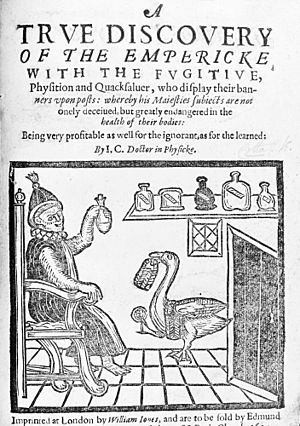John Cotta facts for kids
John Cotta (born 1575, died 1650) was a doctor in England. He wrote books and other texts about medicine and witchcraft.
Contents
Life of John Cotta
John Cotta was born in Coventry, England. His mother might have been Susannah Winthrop, who was the aunt of John Winthrop. John Winthrop later became a famous leader in America.
In 1590, John Cotta started studying at Trinity College, Cambridge. Five years later, he earned his first degree. He then moved to Corpus Christi College. There, he earned his master's degree the next year. In 1603, he became a medical doctor. After that, he lived in Northampton. He became a very successful doctor there, thanks to the help of Sir William Tate.
John Cotta's Writings
Cotta wrote a lot about "quack doctors." These were people who pretended to be doctors but had no real training. In his book Ignorant Practisers of Physicke (1612), he showed how these fake doctors tricked people.
He believed that doctors needed proper education. He argued that just having experience was not enough. Cotta and his friend James Hart, who was also a doctor, said that doctors should have a university degree. They thought this was the best way to practice medicine.
Views on Witchcraft and Magic
John Cotta also believed in evil spirits, sorcerers, and magic. He wrote a book called The Triall of Witch-craft in 1616. In this book, he said that these things were hard for humans to understand. He thought we could only guess about them.
However, Cotta also warned people. He said that many people accused of being witches were actually fakes. Or, they might have been tricked by the devil without knowing it. He used old stories and Bible texts to show that evil spirits existed.
Cotta even used logic to disagree with the "water test" for witches. In this test, a person thought to be a witch was thrown into water. If they floated, they were believed to be a witch. Cotta said this test was wrong.
Still, Cotta agreed with others like Reginald Scot. He thought magic played a part in daily life. This was because many diseases had strange symptoms. Also, some illnesses did not get better with normal treatments. Cotta also said that if enough people saw someone doing witchcraft, that was proof enough to accuse them.
In The Triall of Witch-craft, Cotta wrote:
Hence as Wítches doe strange and supernaturall workes, and truly vnto reason worthy of wonder; so the Impostor doth things voide of accomptable reason, in shadow, shew, and seeming onely supernaturall, wondred and admired. And hence it commeth to passe, that with vndiscerning mindes, they are sometimes mistaken and confounded . one for another.
This means that witches do amazing, unnatural things. But fake people (impostors) also do things that just *look* unnatural. Because of this, people who don't think carefully can mix them up.
John Cotta's Nickname in Maine
Early English settlers in America gave the name "John Cotta" as a nickname. They gave it to a person from the native tribes they met. This happened near the Damariscotta River in what is now Maine. The settlers called him this because John Cotta was known for being an expert on witchcraft. The settlers thought the native people's religion was a form of witchcraft.
See also


